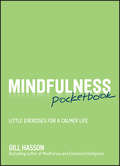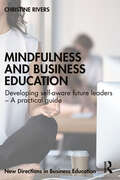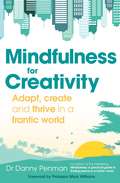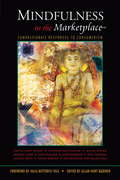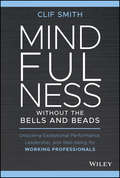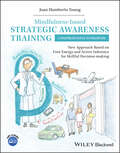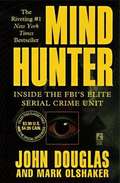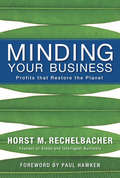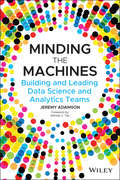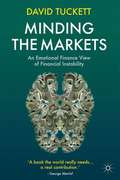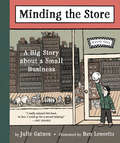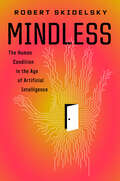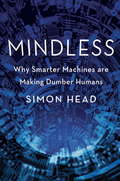- Table View
- List View
Mindfulness Pocketbook
by Gill HassonFollow-up to the bestselling Mindfulness: Be Mindful. Live in the Moment. Gill Hasson, author of the bestselling Mindfulness is back and this time you can fit her advice in your pocket! This little book is packed with over 100 quick exercises, each dealing with a different situation, to help you get calm, collected, and balanced. So whenever you start to feel the stress mounting, reach for your Mindfulness Pocketbook, find the relevant exercise and instantly make life better! So if you feel like life is moving too fast and you're struggling to keep up with constant demands and commitments, don't let anxiety and worry get the better of you -- integrate these mindfulness exercises, practices, and reflections into your daily life and get in control and feel more confident, calm, and present. By progressing through the pocketbook, you will develop mindful ways of thinking and doing that will benefit a wide range of situations in your personal, social, and work life. Slow down, take a deep breath, and take that step toward an easier and more manageable life. The Mindfulness Pocketbook will help you: Move in the direction of greater calm, balance, and wellbeing Increase your insight and awareness Break free from unhelpful thoughts and thinking patterns, feel more confident, and have better self-esteem Be more able to manage other people's demands, stress, anxiety, and worry Experts increasingly recognise that developing mindfulness skills is an effective way to improve performance, reduce stress, enhance emotional intelligence, increase life satisfaction, and develop leadership skills. A mindful person consciously brings awareness to the here-and-now with openness, interest, and receptiveness. Mindfulness Pocketbook is the take-with-you guide to receptive, constructive thinking.
Mindfulness and Business Education: Developing self-aware future leaders – A practical guide (New Directions in Business Education)
by Christine RiversMindfulness and Business Education: Developing self-aware future leaders is a practical guide for educators and academics with teaching responsibilities in business schools or colleges. Business schools have a responsibility to equip future leaders with the right knowledge and the right skills to make the right decisions, particularly in times of volatility, uncertainty, complexity, and ambiguity. This responsibility can only be met if business schools change the way they teach and develop self-aware future leaders who are grounded in the foundations of mindfulness.The book is divided into three parts: Why, What, and How. Part One: Why introduces the foundations of mindfulness, draws on the history of business school development, and discusses leadership approaches presently taught in business schools. Part Two: What discusses ways of measuring mindfulness, the need for training business educators as mindfulness facilitators, and the contextualisation of mindfulness in contemporary business topics such as wellbeing, sustainability, diversity, and artificial intelligence. Part Three: How provides case studies and scripted resources for immediate use and implementation in extracurricular or co-curricular activities to design mindfulness-based modules and courses, to introduce mindfulness coaching as part of pastoral care and staff development, and to develop mindfulness-driven business education strategies.This is an ideal book for those in business education looking to use mindfulness to develop future managers and leaders.
Mindfulness at Work: How to Avoid Stress, Achieve More, and Enjoy Life!
by Stephen McKenzieMindfulness isn’t anything that we think; it’s what we don’t think. Mindfulness isn’t something that other people do; it’s something that we all do. Mindfulness is an ancient, life-enhancing, healing technique that can help us remember our natural state of happiness and health, even if we think we are too modern and too busy to prioritize what’s really important—being fully alive and fully alive to our full life potential.Mindfulness at Work reveals how the practice of mindfulness—the ability to focus our attention on what is rather than be distracted by what isn’t—can be a powerful antidote to the distractions and stresses of our modern lives, especially our working lives. It gives you powerful tools to:Reduce your stressBecome more productiveImprove your decision-making skillsWork more creativelyDevelop your leadership skillsAnd much moreWritten by an expert with years of both clinical and personal experience, Mindfulness at Work includes examples of mindfulness in action in the workplace, while also showing you how to apply its lessons to specific professions, from sales to teaching, from law to medicine, from the trades to the creative arts.
Mindfulness at Work: Turn your job into a gateway to joy, contentment and stress-free living (Mindful Living Ser.)
by Oli DoyleTurn your job into a gateway to joy, contentment and stress-free living, with bestselling author Oli Doyle's six-week guide.In Mindfulness at Work, bestselling author and mindfulness guru Oli Doyle guides you through a a six-week plan to show that even with demanding bosses and stressful environments, we actually can be happy at work. This guide will explore the possibilities that work provides for finding our stuck points, embracing difficult emotions and noticing the patterns of thought that keep us from feeling peaceful. Key learnings include: how to move beyond stressful future thinking to focus on what can be attended to now; how flow can benefit you and your organisation by making you calmer, more alert and more attentive to detail; and how to see work as your teacher rather than your project.The Mindful Living series is a new series of short mindfulness books dedicated to enhance three important areas of our lives: work, relationships and parenting. Oli Doyle shows that all the key domains of life provide great opportunities to practice mindfulness and discover peace of mind.
Mindfulness at Work: Turn your job into a gateway to joy, contentment and stress-free living (Mindful Living Series)
by Oli DoyleTurn your job into a gateway to joy, contentment and stress-free living, with bestselling author Oli Doyle's six-week guide.In Mindfulness at Work, bestselling author and mindfulness guru Oli Doyle guides you through a a six-week plan to show that even with demanding bosses and stressful environments, we actually can be happy at work. This guide will explore the possibilities that work provides for finding our stuck points, embracing difficult emotions and noticing the patterns of thought that keep us from feeling peaceful. Key learnings include: how to move beyond stressful future thinking to focus on what can be attended to now; how flow can benefit you and your organisation by making you calmer, more alert and more attentive to detail; and how to see work as your teacher rather than your project.The Mindful Living series is a new series of short mindfulness books dedicated to enhance three important areas of our lives: work, relationships and parenting. Oli Doyle shows that all the key domains of life provide great opportunities to practice mindfulness and discover peace of mind.
Mindfulness at Work: Turn your job into a gateway to joy, contentment and stress-free living (Mindful Living Series)
by Oli DoyleThe Mindful Living series is a new series of short mindfulness books dedicated to enhance three important areas of our lives: work, relationships and parenting. Bestselling author and mindfulness guru Oli Doyle shows that all the key domains of life provide great opportunities to practice mindfulness and discover peace of mind. In MINDFULNESS AT WORK, Oli guides the reader through a six-week guide to show that even with demanding bosses and stressful environments, we actually can be happy at work. This guide will explore the possibilities that work provides for finding our stuck points, embracing difficult emotions and noticing the patterns of thought that keep us from feeling peaceful. Key learnings include: how to move beyond stressful future thinking to focus on what can be attended to now; how flow can benefit you and your organisation by making you calmer, more alert and more attentive to detail; and how to see work as your teacher rather than your project.The Mindful Living series is for real, flawed, imperfect people who are ready to embrace their challenges and discover a different way of living.Read by Clare Corbett(p) 2017 Orion Publishing Group
Mindfulness for Authentic Leadership: Theory and Cases (Palgrave Studies in Workplace Spirituality and Fulfillment)
by Louise KellyThis book explores the notion of authenticity in leaders and examines how authentic leadership is supported by emotional intelligence (EI), resiliency, and mindfulness. In identifying mindfulness as a key to developing self-awareness along with sincere and transparent relationships with others, the author argues that mindfulness allows leaders to achieve greater authenticity and moral perspective in their leadership journey. As authentic leadership increases empowerment and inclusion, this work pays particular attention to how mindfulness can help support leaders from hisotrically marginalized communities and women leaders to lead in a way that is more congruent with their identities and values. Understanding the antecedents of authentic leadership in mindfulness and other related psychological constructs will extend research on leadership development. Based on empirical studies, as well as theoretical constructs, this book will appeal to researchers with expertise in organizational change, diversity and inclusion, strategy, workplace spirituality, and other topics related to leadership.
Mindfulness for Creativity: Adapt, create and thrive in a frantic world
by Dr Danny PenmanWork deadlines, to-do lists, family commitments, pressure to perform... Our frantic lives demand so much from us that we can often feel locked into a cycle of frustration, anxiety and stress, unable to tackle the tasks before us or see a way out of our habitual ways of thinking and doing things. Yet there is a way out. The simple mindfulness techniques at the heart of this book have been proven to enhance creativity, problem solving and decision making. They also dissolve anxiety, stress and depression while enhancing mental resilience. The four week programme takes just 10-20 minutes per day.The easy-to-follow programme works by soothing and clearing your mind, allowing innovative ideas to take form and crystallise. This helps you to spontaneously 'see' the solution to a problem, to conjure up new ideas, or to create works with true insight and flair. The programme also helps build the courage necessary for you to follow your ideas wherever they should lead - and the resilience to cope with any setbacks. It will help your mind work more effectively so that you can solve problems faster, more intuitively and have the inner confidence to drive your ideas forward. The accompanying CD contains 6 meditations that you can use to build an ongoing practice, mixing and matching meditations to suit your circumstances.
Mindfulness for a More Creative Life: Calm your busy mind, enhance your creativity and find a happier way of living
by Dr Danny PenmanWork deadlines, to-do lists, family commitments, pressure to perform... Our frantic lives demand so much from us that we can often feel locked into a cycle of frustration, anxiety and stress, unable to tackle the tasks before us or see a way out of our habitual ways of thinking and doing things. Yet there is a way out. The simple mindfulness techniques at the heart of this book can help us lead a more creative and productive life - one that is isn't governed by the chaotic pace of life. They also dissolve anxiety, stress and depression while enhancing mental resilience. The four week programme takes just 10-20 minutes per day.The easy-to-follow programme works by soothing and clearing your mind, allowing innovative ideas to take form and crystallise. This helps you to spontaneously 'see' the solution to a problem, to conjure up new ideas, or to create works that have true insight and flair. The programme helps build the courage necessary for you to follow your ideas wherever they should lead - and the resilience to cope with any setbacks. It will help your mind work more effectively so that you canlive more intuitively and have the inner confidence to drive your ideas forward. The accompanying download link contains 6 meditations that you can use to build an ongoing practice, mixing and matching meditations to suit your circumstances
Mindfulness for a More Creative Life: Calm your busy mind, enhance your creativity and find a happier way of living
by Dr Danny PenmanWork deadlines, to-do lists, family commitments, pressure to perform... Our frantic lives demand so much from us that we can often feel locked into a cycle of frustration, anxiety and stress, unable to tackle the tasks before us or see a way out of our habitual ways of thinking and doing things. Yet there is a way out. The simple mindfulness techniques at the heart of this book can help us lead a more creative and productive life - one that is isn't governed by the chaotic pace of life. They also dissolve anxiety, stress and depression while enhancing mental resilience. The four week programme takes just 10-20 minutes per day.The easy-to-follow programme works by soothing and clearing your mind, allowing innovative ideas to take form and crystallise. This helps you to spontaneously 'see' the solution to a problem, to conjure up new ideas, or to create works that have true insight and flair. The programme helps build the courage necessary for you to follow your ideas wherever they should lead - and the resilience to cope with any setbacks. It will help your mind work more effectively so that you canlive more intuitively and have the inner confidence to drive your ideas forward. The accompanying download link contains 6 meditations that you can use to build an ongoing practice, mixing and matching meditations to suit your circumstances
Mindfulness funciona: Cómo desconectar y reducir el estrés
by Beatriz Muñoz ÁlvarezUna introducción a la práctica del mindfulness y su aplicación en el día a día, con el objetivo de aprender a desconectar del ruido y la presión exteriores, conectar con uno mismo y controlar su estrés. Beatriz Muñoz, con su extensa experiencia en la formación de mindfulness, introduce una serie de ejercicios que permitirán al lector aplicar estos planteamientos de forma práctica, con propuestas como la meditación de la espinaca, la de la impresora o la de la ducha. Asimismo, plantea soluciones para situaciones en las que nos enfrentamos a emociones difíciles, como el miedo, la tristeza o la rabia, y propone un plan de entrenamiento de ocho semanas en el que, de forma gradual, iremos incorporando los beneficios del mindfulness en nuestra vida cotidiana. En una sociedad en la que el estrés y la sensación de ansiedad se han extendido hasta convertirse en una auténtica epidemia, Mindfulness funciona proporciona una solución práctica a estos problemas que el lector podrá aplicar desde la primera página, y que le proporcionará resultados visibles en su vida diaria.
Mindfulness in the Marketplace: Compassionate Responses to Consumerism
by Julia Hill Allan Hunt BadinerMindfulness in the Marketplace suggests a reorientation of consumers from passive purchasers to aware, responsible citizens who see the dynamic connection between their purchases and their values. The Middle Path of Buddhism is not to avoid all consumption, but to consume mindfully in a manner that protects ourselves and all living systems. This anthology outlines a path of compassionate resistance to global corporatization, and offers a view of getting into right relationship with the Earth. Includes the Dalai Lama, Thich Nhat Hanh, Stephen Batchelor, and Joanna Macy.
Mindfulness in the Workplace: An Evidence-based Approach to Improving Wellbeing and Maximizing Performance
by Margaret A. Chapman-ClarkeMindfulness-based interventions in organizations offer the potential to build individual and organizational resilience, engage employees and address workplace stress. Mindfulness in the Workplace is a practical guide written for practitioners who want to learn how mindfulness can be used as a change management and organizational development strategy. Drawing from the latest research evidence from neuro- and behavioural science, Mindfulness in the Workplace offers a framework and guidance on how to start evolution- not revolution- in the organization. It ensures the greatest chance of success, showing how to identify the key stakeholders and work with them on understanding the power of a mindfulness initiative, how to identify a mindfulness champion, adapt the language of mindfulness to the context of the organization, establish metrics, and measure return on investment. Mindfulness in the Workplace proposes that HR and OD professionals are best placed to understand the complexity of implementing change in organizational systems and, therefore, the practice of mindfulness need to be brought in-house, even if they bring in external mindfulness coaches to train their leaders. Case studies including Capital One Finance and the NHS Mental Health Trust cover the reasoning behind these initiatives, how they were planned, the barriers they faced, the lessons learned, and their results. This book offers a forum for HR and OD practitioners to hear from other practitioners who have implemented organizational mindfulness-based interventions using change management principles so that they can understand how they might be applied to their own practice and their own organizations.
Mindfulness without the Bells and Beads: Unlocking Exceptional Performance, Leadership, and Well-being for Working Professionals
by Clif SmithUse mindfulness to unleash your potential - without adopting spiritual beliefsMindfulness Without the Bells and Beads: Unlocking Exceptional Performance, Leadership, and Wellbeing for Working Professionals strips away the bells, beads, and hyperbole associated with mindfulness, and explains how you can take your performance and leadership to the next level in just eight weeks, without adopting any spiritual or new age beliefs. Author Clif Smith, a US Army veteran, former diplomat, and CIA-trained former intelligence officer, serves as EY's Americas Mindfulness Leader and Global Mindfulness Network Leader and is internationally recognized for bringing mindfulness to tens of thousands of corporate and government leaders across the globe. In this book, Clif shares teachings and insights to help achieve the tangible benefits of practicing mindfulness as a fundamental part of our professional and personal lives. You'll discover how to: Enhance mental focus, resilience, and decision-making under pressure Increase the impact of your communication and leadership Transcend limiting beliefs, fear, and other psychological barriers to success Connect, understand, and interact with others more effectively Effectively incorporate self-care into a high-performance life Demystify the practice of mindfulness to make it ideal for a corporate setting Perfect for corporate leaders, managers, and executives, and any working professional in a high-pressure or high-performance environment, Mindfulness Without the Bells and Beads also belongs on the bookshelves of anyone who works in a stressful environment and wants to achieve a higher level of success and a better quality of life.
Mindfulness-Based Strategic Awareness Training: A Complete Program For Leaders And Individuals
by Juan Humberto YoungThis is the first book to link mindfulness training and positive psychology to the leadership, strategy and management issues faced by individuals and organizations. Sets out a complete program in Mindfulness-based Strategic Awareness Training (MBSAT), a new form of strengths-based business mindfulness training which enhances participants' ability to perceive opportunities, adapt and grow Draws on research from neuroscience, positive psychology, behavioural finance and management to show how leaders, managers and individuals can build and maintain more resonant relationships and adapt to constant change Includes real-life vignettes, specific instructions and a wealth of resources designed to guide experiential learning including background information, exercises, guidelines, hand-outs, graphics, and guided audio meditations Mindfulness training is increasingly used in organizational contexts - the author is a pioneer in designing and delivering training that applies mindfulness and positive psychology to the strategic challenges of management and business
Mindfulness-based Strategic Awareness Training Comprehensive Workbook: New Approach Based on Free Energy and Active Inference for Skillful Decision-making
by Juan Humberto YoungA comprehensive training program to navigate skillfully in this disruptive, uncertain time This comprehensive workbook provides a mind training based on new findings in neuroscience that will enhance your decision-making skills. Skillful, strategically aware decisions in professional and private life are key for sustainable well-being and flourishing in life. Part 1 provides a conceptual introduction into understanding the brain as a predicting organ, actively inferring, and constantly trying to optimize energy. Part 2 leads you through a systematic training program of 8 sessions to enhance strategic awareness and improve decision-making skills by increasing the precision of our perception and mental processing. The practices are designed to fit in a busy schedule with a focus on the challenges we all grapple with in daily life. While thorough and well-grounded in scientific research this workbook is also pleasant and inspiring to read. It is filled with practical examples and the author’s own life experience. Numerous hand-drawn illustrations inspire also visually. The MBSAT methodology has been tested by practitioners for over 10 years and is widely acclaimed. The government of Singapore, known for its outstanding commitment to education and investment in the human resources of its population, has included MBSAT in its official skill-building program and heavily subsidizes participation in MBSAT training. It is one of the testimonials to the efficacy of MBSAT.
Mindfulness: An Essential Element of Resonant Leadership
by Annie Mckee Richard BoyatzisLeaders develop their resonance and renew themselves by cultivating three essential elements: mindfulness, hope, and compassion. This chapter looks at what mindfulness is, how it works, and how effective leaders cultivate it to manage the inevitable cycle of sacrifice and renewal and to sustain their resonance.
Mindhunter: Inside the FBI's Elite Serial Crime Unit
by John E. DouglasDuring his twenty-five year career with the Investigative Support Unit, Special Agent John Douglas became a legendary figure in law enforcement, pursuing some of the most notorious and sadistic serial killers of our time: the man who hunted prostitutes for sport in the woods of Alaska, the Atlanta child murderer, and Seattle's Green River killer, the case that nearly cost Douglas his life. As the model for Jack Crawford in The Silence of the Lambs, Douglas has confronted, interviewed, and studied scores of serial killers and assassins, including Charles Manson, Ted Bundy, and Ed Gein, who dressed himself in his victims' peeled skin. Using his uncanny ability to become both predator and prey, Douglas examines each crime scene, reliving both the killer's and the victim's actions in his mind, creating their profiles, describing their habits, and predicting their next moves. Now, in chilling detail, the legendary Mindhunter takes us behind the scenes of some of his most gruesome, fascinating, and challenging cases -- and into the darkest recesses of our worst nightmares.
Minding My Business: The Complete, No-Nonsense, Start-to-Finish Guide to Owning and Running Your Own Store
by Adeena MignognaTaking a leap and making the choice to start a business can be hard, but all that comes after--the planning, loans, marketing--can be even harder. Every new business owner needs an easy, clear, and useful guide to follow when embarking on this venture, and Minding My Business will make the process as simple as possible. With no previous business experience, Adeena Mignogna decided to open up her own retail store, a paint-your-own pottery studio. In this part memoir, part handbook, she details all the things she did right, and wrong, so that anyone following in her footsteps won't make the same mistakes. Minding My Business explains how to: Deal with leasing and landlordsObtain loans and manage financesHire, retain, and treat employeesMarket and advertise your businessDeal with stressful situationsCreate an exit strategy if you decide to closeSell your businessAnd everything in betweenMignogna chronicles all that went into opening the doors to her store, successfully managing it for several years, and then finally deciding to close it. If you're ready to take the risk, you'll need this book to help you navigate through the tough and perplexing world of small business.
Minding Your Business
by Paul Hawken Horst RechelbacherThe business world is at a crisis point- the bubble is going to burst soon. New ways of doing business have to be found. We can't keep repeating the past or the present. Rechelbacher contends that the biggest business opportunities for the next century will come from practicing environmentally sound, sustainable business that is in harmony with the rhythms of the natural world. The first step in this process is aligning ourselves with the natural world. By managing our personal lives as if they were corporations and putting them in line with what we observe in nature, we will be able to align our businesses with the environment as well, reaping the rewards of a healthy, sustainable abundance.
Minding the Machines: Building and Leading Data Science and Analytics Teams
by Jeremy AdamsonOrganize, plan, and build an exceptional data analytics team within your organization In Minding the Machines: Building and Leading Data Science and Analytics Teams, AI and analytics strategy expert Jeremy Adamson delivers an accessible and insightful roadmap to structuring and leading a successful analytics team. The book explores the tasks, strategies, methods, and frameworks necessary for an organization beginning their first foray into the analytics space or one that is rebooting its team for the umpteenth time in search of success. In this book, you’ll discover: A focus on the three pillars of strategy, process, and people and their role in the iterative and ongoing effort of building an analytics team Repeated emphasis on three guiding principles followed by successful analytics teams: start early, go slow, and fully commit The importance of creating clear goals and objectives when creating a new analytics unit in an organization Perfect for executives, managers, team leads, and other business leaders tasked with structuring and leading a successful analytics team, Minding the Machines is also an indispensable resource for data scientists and analysts who seek to better understand how their individual efforts fit into their team’s overall results.
Minding the Markets: An Emotional Finance View of Financial Instability
by David TuckettTuckett argues that most economists' explanations of the financial crisis miss its essence; they ignore critical components of human psychology. He offers a deeper understanding of financial market behaviour and investment processes by recognizing the role played by unconscious needs and fears in all investment activity.
Minding the Store: A Big Story about a Small Business
by Julie Gaines&“I really enjoyed this book. In fact, I could go for a second helping!&”—Amy Sedaris &“Entrepreneurs will learn a thing or two about translating a dream into thoughtful business growth, and everyone will laugh, cry, and nod along with a woman who has chosen to live an extraordinary life amidst many piles of dishes.&” —Danny Meyer, CEO of Union Square Hospitality Group, founder of Shake Shack, author of the New York Times bestseller Setting the Table In this charming graphic memoir, the founder of an iconic housewares shop recounts the ups and downs—and ups again—of starting a family business, starting a family, and staying true to one&’s path while trying to make it in the Big City. Whether it&’s a set of vintage plates from a 1920s steamship, a mug with a New Yorker cartoon on it, a tin of sprinkles designed by Amy Sedaris, or a juice glass from a Jazz Age hotel, Fishs Eddy products are distinctly recognizable. A New York institution, Fishs Eddy also remains a family business whose owners endured the same challenges as many family businesses—and lived to write about it in this tale filled with humorous characterizations of opinionated relatives, nosy neighbors, quirky employees, and above all the eccentric foibles of the founders themselves. Readers come to know author Julie Gaines and her husband, with whom she founded the store, and because this is a family business, the illustrations are all in the family, too: their son Ben Lenovitz&’s drawings bring Fishs Eddy to life with a witty style a la Roz Chast and Ben Katchor. Over the years the store has collaborated with artists and celebrities such as Charley Harper and Todd Oldham, Alan Cumming, and many others to produce original designs that are now found in thousands of stores throughout the country, and Fishs Eddy has garnered a huge amount of media coverage. A great gift for anyone who has ever dreamed of opening a little business—or anyone with any kind of dream—Minding the Store offers wisdom, inspiration, and an exceedingly entertaining story.
Mindless: The Human Condition in the Age of Artificial Intelligence
by Robert SkidelskyThis sweeping history of humanity&’s relationship with machines illuminates how we got here and what happens next, with AI, climate change, and beyond.Faith in technological fixes for our problems is waning. Automation, which promised relief from toil, has reactivated the long-standing fear of job redundancy. Information technology, meant to liberate us from traditional authority, is placing unprecedented powers of surveillance and control in the hands of a purely secular Big Brother. And for the first time, artificial intelligence threatens anthropogenic disaster—disaster caused by our own activities. Scientists join imaginative writers in warning us of the fate of Icarus, whose wings melted because he flew too close to the sun.This book tells the story of our fractured relationship with machines from humanity&’s first tools down to the present and into the future. It raises the crucial question of why some parts of the world developed a &“machine civilization&” and not others, and traces the interactions between capitalism and technology, and between science and religion, in the making of the modern world.Taking in the peaks of philosophy and triumphs of science, the foundation of economics and speculations of fiction, Robert Skidelsky embarks on a bold intellectual journey through the evolution of our understanding of technology and what this means for our lives and politics.
Mindless: Why Smarter Machines are Making Dumber Humans
by Simon HeadThe tools of corporate efficiency - expert systems, databases, and operations management - have improved our lives significantly, but with a cost: they're turning us into mindless drones. This book traces how these IT-intensive management systems have come to dominate our lives, with a profound effect in particular on the middle class.
